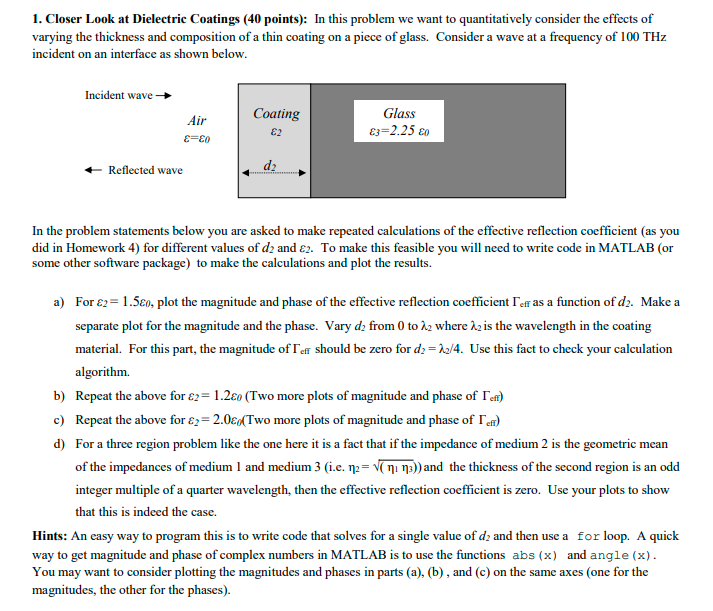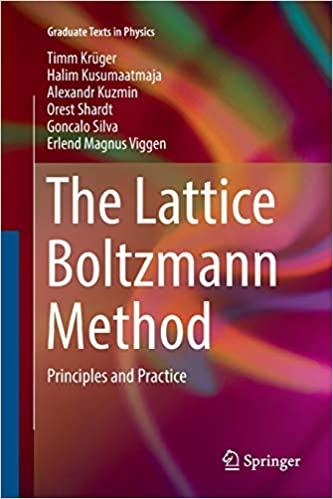Show all steps neat and correct Solve asap!! 
1. Closer Look at Dielectric Coatings (40 points): In this problem we want to quantitatively consider the effects of varying the thickness and composition of a thin coating on a piece of glass. Consider a wave at a frequency of 100THz incident on an interface as shown below. In the problem statements below you are asked to make repeated calculations of the effective reflection coefficient (as you did in Homework 4) for different values of d2 and 2. To make this feasible you will need to write code in MATLAB (or some other software package) to make the calculations and plot the results. a) For 2=1.50, plot the magnitude and phase of the effective reflection coefficient eff as a function of d2. Make a separate plot for the magnitude and the phase. Vary d2 from 0 to 2 where 2 is the wavelength in the coating material. For this part, the magnitude of eff should be zero for d2=2/4. Use this fact to check your calculation algorithm. b) Repeat the above for 2=1.20 (Two more plots of magnitude and phase of eff ) c) Repeat the above for 2=2.00 (Two more plots of magnitude and phase of eff ) d) For a three region problem like the one here it is a fact that if the impedance of medium 2 is the geometric mean of the impedances of medium 1 and medium 3 (i.e. 2=(13) ) and the thickness of the second region is an odd integer multiple of a quarter wavelength, then the effective reflection coefficient is zero. Use your plots to show that this is indeed the case. Hints: An easy way to program this is to write code that solves for a single value of d2 and then use a for loop. A quick way to get magnitude and phase of complex numbers in MATLAB is to use the functions abs ( x ) and angle ( x ). You may want to consider plotting the magnitudes and phases in parts (a), (b), and (c) on the same axes (one for the magnitudes, the other for the phases). 1. Closer Look at Dielectric Coatings (40 points): In this problem we want to quantitatively consider the effects of varying the thickness and composition of a thin coating on a piece of glass. Consider a wave at a frequency of 100THz incident on an interface as shown below. In the problem statements below you are asked to make repeated calculations of the effective reflection coefficient (as you did in Homework 4) for different values of d2 and 2. To make this feasible you will need to write code in MATLAB (or some other software package) to make the calculations and plot the results. a) For 2=1.50, plot the magnitude and phase of the effective reflection coefficient eff as a function of d2. Make a separate plot for the magnitude and the phase. Vary d2 from 0 to 2 where 2 is the wavelength in the coating material. For this part, the magnitude of eff should be zero for d2=2/4. Use this fact to check your calculation algorithm. b) Repeat the above for 2=1.20 (Two more plots of magnitude and phase of eff ) c) Repeat the above for 2=2.00 (Two more plots of magnitude and phase of eff ) d) For a three region problem like the one here it is a fact that if the impedance of medium 2 is the geometric mean of the impedances of medium 1 and medium 3 (i.e. 2=(13) ) and the thickness of the second region is an odd integer multiple of a quarter wavelength, then the effective reflection coefficient is zero. Use your plots to show that this is indeed the case. Hints: An easy way to program this is to write code that solves for a single value of d2 and then use a for loop. A quick way to get magnitude and phase of complex numbers in MATLAB is to use the functions abs ( x ) and angle ( x ). You may want to consider plotting the magnitudes and phases in parts (a), (b), and (c) on the same axes (one for the magnitudes, the other for the phases)







